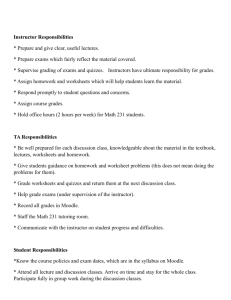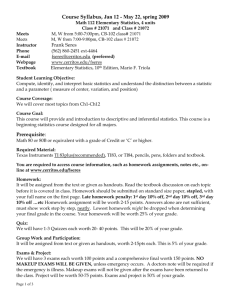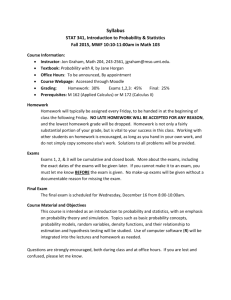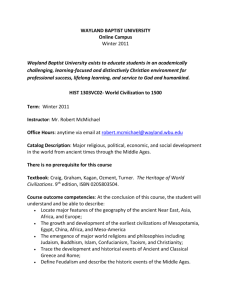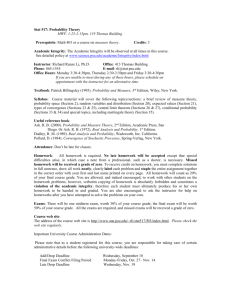Proposal File - Teaching Large Classes
advertisement
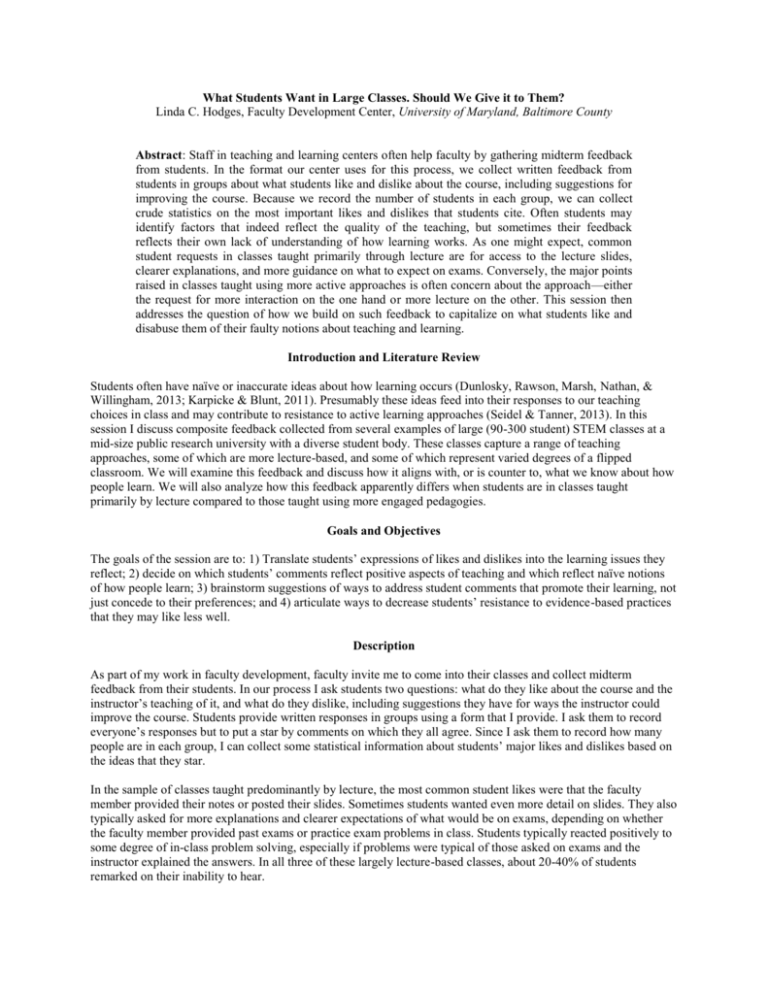
What Students Want in Large Classes. Should We Give it to Them? Linda C. Hodges, Faculty Development Center, University of Maryland, Baltimore County Abstract: Staff in teaching and learning centers often help faculty by gathering midterm feedback from students. In the format our center uses for this process, we collect written feedback from students in groups about what students like and dislike about the course, including suggestions for improving the course. Because we record the number of students in each group, we can collect crude statistics on the most important likes and dislikes that students cite. Often students may identify factors that indeed reflect the quality of the teaching, but sometimes their feedback reflects their own lack of understanding of how learning works. As one might expect, common student requests in classes taught primarily through lecture are for access to the lecture slides, clearer explanations, and more guidance on what to expect on exams. Conversely, the major points raised in classes taught using more active approaches is often concern about the approach—either the request for more interaction on the one hand or more lecture on the other. This session then addresses the question of how we build on such feedback to capitalize on what students like and disabuse them of their faulty notions about teaching and learning. Introduction and Literature Review Students often have naïve or inaccurate ideas about how learning occurs (Dunlosky, Rawson, Marsh, Nathan, & Willingham, 2013; Karpicke & Blunt, 2011). Presumably these ideas feed into their responses to our teaching choices in class and may contribute to resistance to active learning approaches (Seidel & Tanner, 2013). In this session I discuss composite feedback collected from several examples of large (90-300 student) STEM classes at a mid-size public research university with a diverse student body. These classes capture a range of teaching approaches, some of which are more lecture-based, and some of which represent varied degrees of a flipped classroom. We will examine this feedback and discuss how it aligns with, or is counter to, what we know about how people learn. We will also analyze how this feedback apparently differs when students are in classes taught primarily by lecture compared to those taught using more engaged pedagogies. Goals and Objectives The goals of the session are to: 1) Translate students’ expressions of likes and dislikes into the learning issues they reflect; 2) decide on which students’ comments reflect positive aspects of teaching and which reflect naïve notions of how people learn; 3) brainstorm suggestions of ways to address student comments that promote their learning, not just concede to their preferences; and 4) articulate ways to decrease students’ resistance to evidence-based practices that they may like less well. Description As part of my work in faculty development, faculty invite me to come into their classes and collect midterm feedback from their students. In our process I ask students two questions: what do they like about the course and the instructor’s teaching of it, and what do they dislike, including suggestions they have for ways the instructor could improve the course. Students provide written responses in groups using a form that I provide. I ask them to record everyone’s responses but to put a star by comments on which they all agree. Since I ask them to record how many people are in each group, I can collect some statistical information about students’ major likes and dislikes based on the ideas that they star. In the sample of classes taught predominantly by lecture, the most common student likes were that the faculty member provided their notes or posted their slides. Sometimes students wanted even more detail on slides. They also typically asked for more explanations and clearer expectations of what would be on exams, depending on whether the faculty member provided past exams or practice exam problems in class. Students typically reacted positively to some degree of in-class problem solving, especially if problems were typical of those asked on exams and the instructor explained the answers. In all three of these largely lecture-based classes, about 20-40% of students remarked on their inability to hear. In the active learning classes sampled, students more often remarked positively on the faculty member’s enthusiasm or caring personality. About one fourth of students liked the active learning environment and use of clickers, for example, and one fourth wanted more lecture. Because these classes often used publisher’s materials for pre-class preparation, how well these materials worked were more likely to be a source of appreciation or complaint. What do these ideas suggest about students’ learning needs and how they are or are not met in a large class? If students rely more on the instructor for content, then students typically want that content to be as clear, complete, and specific—and loud—as possible and provided to them in written form. They also often feel less clear about expectations for tests, and they may express the need for some kind of in-class practice. In active learning classes, the emphasis seems to shift somewhat. Perhaps because the instructor is more of a facilitator and less of a content provider, students may notice the instructor’s demeanor more. Interestingly, too, perhaps because active learning may still not be the norm for students in large classes, they are more apt to remark positively or negatively on it than they do in a primarily lecture-based course. Discussion How do we respond to such feedback? Should we provide students with lecture notes? Should we force them to take handwritten notes? Should we provide practice exams outside of class and examples of test questions as practice in class? Should we force them to be actively engaged? Should we assign web-based homework? The answer to all these questions based on the research is predominantly, “Yes.” The amount of content and rate of delivery in lectures can easily exceed students’ cognitive load capacity (Sweller, 1988). Thus, providing students with some of our main points in advance via handout or slides allows them more working memory space to process ideas. Not providing them with every detail, however, forces them to engage with the material during class, hopefully taking notes by hand to begin to encode that information (Mueller & Oppenheimer, 2014). Pausing frequently to assess if students are understanding, by engaging them in answering questions or solving a sample problem, helps students process information and start it on its way to long-term memory. As we can see from some of this feedback and the literature, however, students do not always appreciate our attempts at active learning. Building a rapport with students is one critical step needed to help them buy in to our choices (Seidel & Tanner, 2013). Being transparent with students about why we make these choices and how we have their best interests at heart is important in helping students accept an approach that may be a bit uncomfortable for them. And providing a “map” via clear expectations and organization is required for them to navigate the unfamiliar terrain of engaged learning. During this session, we will discuss these issues via whole group brainstorming and small group problem solving, in essence modeling some effective approaches in large classes. References Dunlosky, J., Rawson, K. A., Marsh, E. J., Nathan, M. J., & Willingham, D. T. (2013). Improving students’ learning with effective learning techniques: Promising directions from cognitive and educational psychology. Psychological Science in the Public Interest, 14(1), 4-58. Karpicke, J. D., & Blunt, J. R. (2011). Retrieval practice produces more learning than elaborative studying with concept mapping. Science, 331(6018), 772-775. Mueller, P. A., & Oppenheimer, D. M. (2014). The pen is mightier than the keyboard: Advantages of longhand over laptop note taking. Psychological Science, 25(6), 1159-1168. Seidel, S. B., & Tanner, K. D. (2013). “What if students revolt?” Considering student resistance: Origins, options, and opportunities for investigation. CBE-Life Sciences Education, 12(4), 586-595. Sweller, J. (1988). Cognitive load during problem solving: Effects on learning. Cognitive Science, 12, 257-285.



